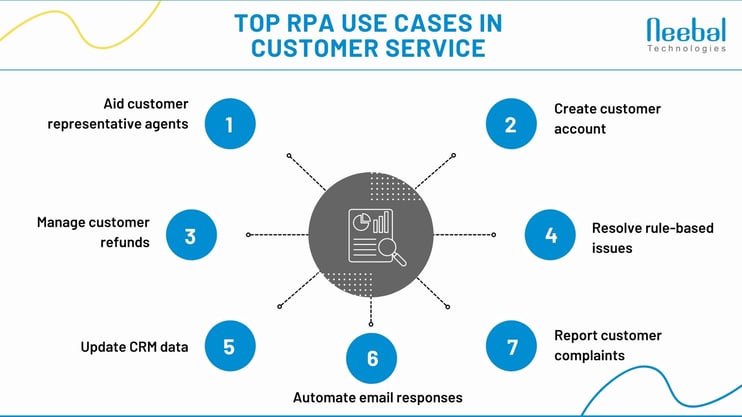A recent AI Multiple report states that more than 20% of organizations have adopted RPA for automating multiple back-office tasks. Since RPA bots are capable of seamlessly tackling rule-based repetitive tasks, they significantly reduce the workload of customer service reps. This is done by reporting customer inquiries and complaints, fetching answers for customers from business databases, updating customer information, and transferring calls to human agents.
RPA bots replicate human communications with GUI (Graphical User Interface) elements and execute rule-based repetitive tasks such as downloading customer emails, answering FAQs, or fetching information from the database (e.g. shipments, prices, troubleshooting). Thus, RPA enhances customer service by:
- Ensuring prompt and accurate responses
- Limiting data errors (file transfer duplicates, non-updated information, unverified customer data)
- Collecting data for analytics
- Reducing customer service reps’ workload
- Answering queries 24*7
Top RPA use cases in customer service
Here are the top ways in which RPA is used to automate tasks in customer service:

1. Aid customer representative agents
According to research by Salesforce, 63% of customers expect service reps to know their unique expectations and needs, including what they have bought. RPA bots seamlessly tackle this problem by fetching the customer’s data, such as purchases, demographics, previous tickets, or complaints, and providing it beforehand to the customer service personnel to help them probe customers’ inquiries, and resolve the issue quickly.
2. Create customer account
Each customer has their personal account in the business CRM database including their customer ID, name, credit card information, contact information, and purchase history. Customers typically create an account by communicating with a customer rep or a bot in a recorded chat. The bot automatically extracts the relevant information from the recorded communication, fills out forms to create the customer account, validates the payment mode against bank information, and notifies the customers of account details once it's finalized.
3. Manage customer refunds
RPA bots extract customer refund inquiries from ticketing systems, emails, or texts, and initiate refund processes without requiring human intervention. The bots also send notifications to the user via text or email informing them of the refund completion.
4. Resolve rule-based issues
Issue information is collected and stored in the ticket system via RPA bots. They access the ticket database and automatically resolve customer queries such as text to inform:
- Modifying orders (request return code, change delivery address)
- Renewing customer login information or password
- Modifying payment information (pay-at-the-door, credit card number)
5. Update CRM data
RPA bots automatically pull data from business databases (e.g.interactions with customer service employees, customers’ past purchases, documents and reports, cold calls, and emails) and update it into CRM data (e.g. lead scoring, order history, contact history) with information from new texts, emails, filed reports, or online surveys.
Based on the assigned priority level, an automated workflow for issue resolution is created, and the customer is updated with the refund decision.
6. Report customer complaints
RPA bots leverage OCR and NLP to analyze customer complaints in texts or emails, extract complaint data (e.g. package delay, service downtime, wrong delivery) and input it into text documents or spreadsheets and generate reports that are either:
- Used for detecting issue patterns
- Logged for compliance and audit
- Sent to relevant customer support employees
7. Automate email responses
RPA bots pull data from multiple databases and generate emails in response to customer requests or queries. For instance, bots fetch data from:
- FAQ database to answer emails about shop or warehouse locations and opening hours.
- Logistics database to generate an email about shipment tracking or delay information.
- Marketing database to provide information about coupons and promotions.
- Finance database to generate invoices to customers and send them via email.
- IT documentation to answer product troubleshooting inquiries.
Moreover, RPA bots generate ticket closure emails and remit them to customers who have opened an issue ticket or filed a complaint.
Conclusion
To surmise, every customer wants a customized treatment. By leveraging RPA solutions, enterprises deliver an incredible customer experience, helping them feel valued and special, thereby enabling a loyal customer base.
Deploying RPA is well worth the returns, especially when a reputed RPA solutions provider like Neebal can provide you unlimited license free bots, helping you save expenses on recurring bot license renewals. Our team of experienced technology experts enables fast solution development and implementation. Would you like to reap the benefits of automation too? We’re here to help! Schedule a call today with one of our top experts to get started!
